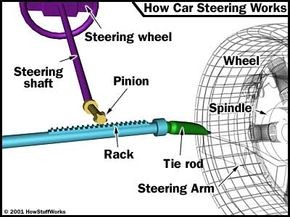Rack And Pinion steering is the most common steering system in modern cars, trucks, and SUVs. Its simplicity and efficiency make it a reliable choice for converting steering wheel rotation into wheel movement. This article explains how the rack and pinion mechanism works, its advantages, and variations like power steering.
 alt text describing image of a rack and pinion steering system identifying parts
alt text describing image of a rack and pinion steering system identifying parts
How Rack and Pinion Steering Works
The rack and pinion mechanism consists of a circular gear (pinion) engaged with a toothed rack. The pinion is connected to the steering shaft. When the steering wheel is turned, the pinion rotates, moving the rack linearly. Tie rods connected to each end of the rack transfer this linear motion to the steering arms on the spindles, causing the wheels to turn.
This system effectively converts rotational motion into linear motion while providing a gear reduction. The gear reduction makes it easier to turn the wheels, requiring less effort from the driver. Typically, three to four turns of the steering wheel are needed to move the wheels from their furthest left to furthest right position (lock-to-lock).
Steering Ratio Explained
The steering ratio describes the relationship between steering wheel rotation and wheel movement. It’s calculated by dividing the steering wheel rotation angle by the resulting wheel turning angle. For example, a 18:1 ratio means that for every 18 degrees the steering wheel turns, the wheels turn 1 degree.
A higher steering ratio requires more steering wheel movement for a given wheel turn but reduces the effort needed. Lower ratios provide quicker steering response, requiring less steering input for the same wheel movement, often preferred in sportier vehicles.
Variable-Ratio Steering
Some vehicles utilize variable-ratio steering, employing a rack and pinion with varying tooth spacing. This design provides quicker response in the center position for initial turns and reduces effort at the wheel’s turning limits. This dynamic adjustment improves both maneuverability and driver comfort.
Power Rack and Pinion Steering
Power steering enhances the rack and pinion system by adding hydraulic assistance. A piston incorporated within the rack is connected to two fluid ports. High-pressure fluid directed to one side of the piston moves the rack, providing the power assist that reduces the effort required to turn the steering wheel.
Conclusion
The rack and pinion steering system has become a mainstay in modern vehicles due to its simplicity, efficiency, and adaptability. Understanding its core principles, including steering ratio and the benefits of power steering, provides valuable insight into how this essential system contributes to vehicle control and maneuverability.
